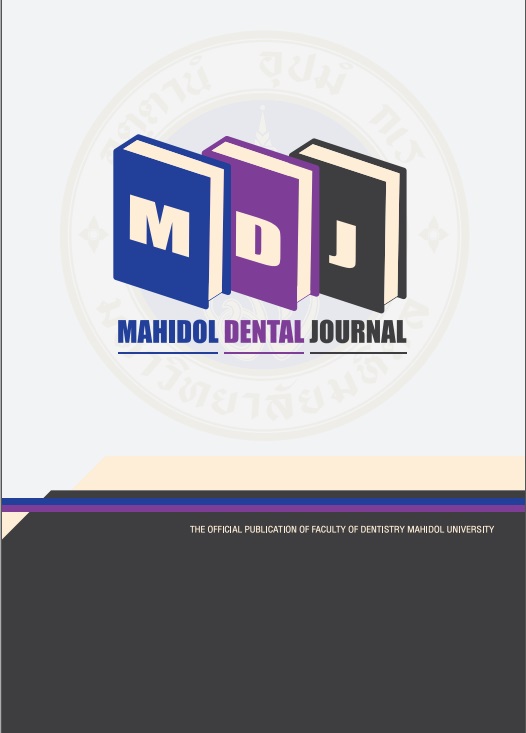Effect of dentin cleansing techniques on the shear bond strength of self-adhesive resin cement after temporary bonding with two provisional cements
Main Article Content
Abstract
Objective: The objective of this study was to evaluate the effect of different cleansing techniques on the shear bond strength of self-adhesive cement to dentin after temporary fixation with two provisional cements.
Materials and Methods: Ninety human premolars were sectioned horizontally and embedded in self-cured acrylic resin blocks. Self-cured acrylic discs were fixed on the dentin surfaces with two provisional cements, zinc oxide non-eugenol temporary cement (TempBond NE) or temporary resin-based cement (TempBond Clear). The specimens were stored in distilled water at 37˚C. After 5 d, the provisional restorations were removed and randomly divided into 5 groups (n=10), based on cleansing treatments: no temporary cement (control group), explorer, prophy brush with pumice, rubber cup with pumice, and ultrasonic scaler. Self-adhesive cement (RelyX U200, 3M ESPE) was applied into a metal mold (3 mm diameter, 2 mm thick), which was placed on the dentin surfaces and polymerized with a light-emitting diode curing unit for 40 sec. The specimens were stored in distilled water at 37 ˚C for 24 h. The shear bond strength test was performed with a universal testing machine at a crosshead speed of 0.5 mm/min until failure. The data were analyzed using two-way analysis of variance (ANOVA) and post-hoc Dunnett T3 test.
Results: There were no significant differences in shear bond strength between the two types of temporary cement and cleansing methods (p=0.105 and 0.083, respectively). The control group presented a significantly higher shear bond strength compared with the prophy brush with pumice and rubber cup with pumice in TempBond NE groups (p=0.001 and 0.005, respectively). The control group also had a significantly higher shear bond strength compared with the explorer (p=0.004) in TempBond Clear group.
Conclusion: Cleansing methods and types of temporary cements did not affect the shear bond strength of self-adhesive resin cement and dentin. However, cleaning temporary resin-based cement with an explorer generated the significantly lowest shear bond strength in the TempBond Clear group.
Article Details

This work is licensed under a Creative Commons Attribution-NonCommercial-NoDerivatives 4.0 International License.
References
Goodacre CJ, Bernal G, Rungcharassaeng K, Kan JYK. Clinical complications in fixed prosthodontics. J Prosthet Dent 2003; 90: 31-41.
Santos GC Jr, Santos MJ. Selecting a temporary cement: a case report. Dent Today 2012; 31: 96-99.
Santos MJ, Bapoo H, Rizkalla AS, Santos GC. Effect of dentin-cleaning techniques on the shear bond strength of self-adhesive resin luting cement to dentin. Oper Dent 2011; 36: 512-20.
Paul SJ, Scharer P. Effect of provisional cements on the bond strength of various adhesive bonding systems on dentine. J Oral Rehabil 1997; 24: 8-14.
Rosenstiel SF, Land MF, Crispin BJ. Dental luting agents: A review of the current literature. J Prosthet Dent 1998; 80: 280-301.
Ayad MF, Rosenstiel SF, Hassan MM. Surface roughness of dentin after tooth preparation with different rotary instrumentation. J Prosthet Dent 1996; 75: 122-28.
Terata R. Characterization of enamel and dentin surfaces after removal of temporary cement--study on removal of temporary cement. Dent Mater J 1993; 12: 18-28.
Tetsuka N. Influence of temporary cement on dentin permeability. Japan J Conserv Dent 1993; 36: 822–28.
Chiluka L, Shastry YM, Gupta N, Reddy KM, Prashanth NB, Sravanthi K. An in vitro study to evaluate the effect of eugenol-free and eugenol-containing temporary cements on the bond strength of resin cement and considering time as a factor. J Int Soc Prev Community Dent 2017; 7: 202-07.
Ajaj R, Al-Mutairi S, Ghandoura S. Effect of eugenol on bond strength of adhesive resin: A systematic review. OHDM 2014; 13: 950–58.
ISO/TS 11405: 2015 - Dentistry - Testing of adhesion to tooth structure [WWW Document], n.d.
URL https://www.iso.org/standard/62898.html (accessed 5.17.18).
Sarac D, Sarac YS, Kulunk S, Kulunk T. Effect of the dentin cleaning techniques on dentin wetting and on the bond strength of a resin luting agent. J Prosthet Dent 2005; 94: 363- 69.
Can-Karabulut DC, OZ FT, Karabulut B, Batmaz I, and Ilk O. Adhesion to Primary and Permanent Dentin and a Simple Model Approach. Eur J Dent. 2009 Jan; 3: 32–41.
Takimoto M, Ishii R, Iino M, Shimizu Y, Tsujimoto A, Takamizawa T, et al. Influence of temporary cement contamination on the surface free energy and dentine bond strength of self-adhesive cements. J Dent 2012; 40: 131-38
Ganss C, Jung M. Effect of eugenol-containing temporary cements on bond strength of composite to dentin. Oper Dent 1998; 23: 55-62.
Peutzfeldt A, Asmussen E. Influence of eugenol-containing temporary cement on bonding of self-etching adhesives to dentin. J Adhes Dent 2006; 8: 31-34.
Román-Rodríguez JL, Millan-Martínez D, Fons-Font A, Agustín-Panadero R, Fernández-Estevan L. Traction test of temporary dental cements. J Clin Exp Dent. 2017; 9: e564-8.
Altintas SH, Tak O, Secilmis A, Usumez A. Effect of provisional cements on shear bond strength of porcelain laminate veneers. Eur J Dent 2011; 5: 373-79.
Sol E, Espasa E, Boj JR, Canalda C. Effect of different prophylaxis methods on sealant adhesion. J Clin Pediatr Dent 2000; 24: 211-14.
Yap AU, Shah KC, Loh ET, Sim SS, Tan CC. Influence of eugenol-containing temporary restorations on bond strength of composite to dentin. Oper Dent 2001; 26: 556-61.


